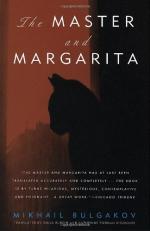|
This section contains 8,162 words (approx. 28 pages at 300 words per page) |

|
SOURCE: Testa, Carlo. “Bulgakov's Master i Margarita: Post-Romantic Devil Pacts.” Canadian-American Slavic Studies 24, no. 3 (fall 1990): 257-78.
In the following essay, Testa traces the development of the devil figure in post-Romantic European literature and Bulgakov's use of the devil in The Master and Margarita.
The Evil One is gone, the evil ones remain. Den Bösen sind sie los, die Bösen sind geblieben.
Goethe, Faust1
I. the Diffraction of Evil
The first half of the nineteenth century was characterized by a high degree of epistemological optimism. The systems of philosophical idealism (Fichte, Schelling, Hegel), which placed the self at the center of material reality, not only played an influential role as cultural vehicles of a certain centripetal view of the world, but, even more importantly, were in and of themselves the expression of an atmosphere in which ontological primacy went to a self-founding—and thereby necessarily world-founding—concept...
|
This section contains 8,162 words (approx. 28 pages at 300 words per page) |

|


